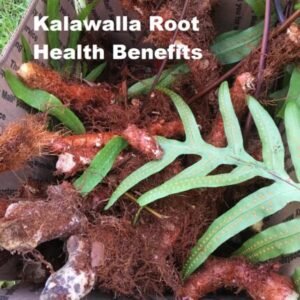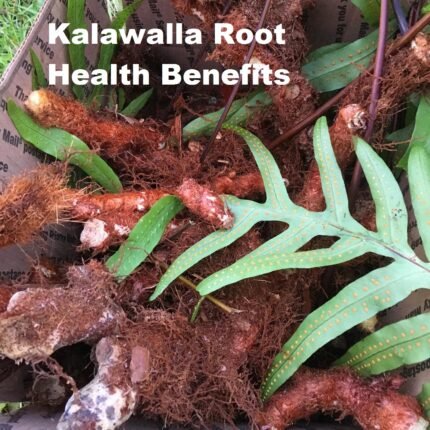Medically reviewed by Dr. Ramesh Gaddam, M.D. — Written by Sumalatha, D.N.H.E
Table of Contents
ToggleKalawalla root, also called Polypodium leucotomos, is a plant that grows in Central and South America. People have used it for its health benefits for a long time. Researchers have found that it may help with skin health and could support the immune system.
This plant has become more popular as people learn more about its potential to improve health.
1. Kalawalla Root Health Benefits

Kalawalla root, also known as Polypodium leucotomos, is praised for several potential health benefits, supported by both traditional use and modern research.
Here are some of the key benefits:
Skin Health:
One of the most well-known benefits of Kalawalla root is its ability to support skin health. It is often used to help protect the skin from sun damage and to maintain a healthy appearance.
Antioxidant Properties:
Kalawalla root contains antioxidants that may help protect cells from damage caused by free radicals, which can contribute to aging and various diseases.
Immune Support:
It is believed that Kalawalla root may help support the immune system, potentially enhancing its ability to defend against infections and illnesses.
Anti-inflammatory Effects:
Some studies suggest that Kalawalla root has anti-inflammatory properties, which may help reduce inflammation in the body and alleviate symptoms of inflammatory conditions.
Potential for Autoimmune Conditions:
There is ongoing research into the use of Kalawalla root for autoimmune conditions like rheumatoid arthritis and lupus. It is thought to modulate immune responses that contribute to these conditions.
Digestive Health:
Traditional use includes the belief that Kalawalla root can support digestive health, although scientific evidence in this area is still limited.
General Well-being:
Some users report improved overall well-being and vitality when using Kalawalla root, although individual responses may vary.
Summary
It’s important to note that while Kalawalla root shows promise for various health benefits, more research, especially large-scale clinical trials, is needed to fully understand its efficacy and safety.
As with any supplement or herbal remedy, it’s advisable to consult with a healthcare professional before starting to ensure it is appropriate for your individual health needs and to discuss potential interactions with medications or existing conditions.
2. Side Effects

While Kalawalla root (Polypodium leucotomos) is generally considered safe for most people when taken appropriately, there are a few potential side effects and considerations to be aware of:
Allergic Reactions:
Some individuals may be allergic to Kalawalla root. If you have a known allergy to ferns or similar plants, you should avoid using products containing Kalawalla root.
Skin Sensitivity:
Although Kalawalla root is often used for skin health, in rare cases, it may cause mild skin irritation or rash. It’s recommended to test a small area of skin before applying it more widely.
Digestive Upset:
There have been occasional reports of digestive upset, such as nausea or stomach discomfort, particularly when taken in higher doses or by sensitive individuals.
Drug Interactions:
Kalawalla root may interact with certain medications, particularly those that affect the immune system or liver function. If you are taking medications or have underlying health conditions, consult with a healthcare professional before using Kalawalla root supplements.
Pregnancy and Breastfeeding:
There is limited information on the safety of Kalawalla root during pregnancy and breastfeeding. It’s advisable for pregnant or breastfeeding women to avoid its use unless recommended by a healthcare provider.
Not Well Studied:
While Kalawalla root has been used traditionally and shows promise in some areas, its long-term safety and potential side effects have not been extensively studied in large clinical trials.
As with any supplement or herbal remedy, it’s important to use Kalawalla root cautiously, follow recommended dosages, and consult with a healthcare provider if you have any concerns or experience any adverse effects.
3. Uses of Kalawalla Root

Kalawalla root, scientifically known as Polypodium leucotomos, is utilized for various purposes, primarily due to its potential health benefits. Here are some common uses:
Skin Health:
Kalawalla root is often used to support skin health and protect against sun damage. It is believed to help maintain skin’s elasticity, reduce redness, and promote overall skin health.
Sun Protection:
It is used as a natural supplement to enhance the skin’s resilience to sun exposure, potentially reducing the harmful effects of UV radiation.
Immune Support:
Some people use Kalawalla root to boost immune function, believing it may help the body resist infections and maintain overall immune health.
Anti-inflammatory Properties:
Due to its potential anti-inflammatory effects, Kalawalla root is sometimes used to alleviate symptoms of inflammatory conditions like arthritis and eczema.
Antioxidant Benefits:
It contains antioxidants that can help protect cells from damage caused by free radicals, which contribute to aging and various diseases.
General Wellness:
Some individuals use Kalawalla root as a dietary supplement to support overall well-being and vitality.
Autoimmune Conditions:
There is ongoing research into the use of Kalawalla root for autoimmune disorders like rheumatoid arthritis and lupus, as it may help modulate immune responses.
Digestive Health:
Traditionally, it has been used to support digestive health, although scientific evidence in this area is still limited.
Summary:
It’s important to note that while Kalawalla root shows promise in these areas, more research is needed to fully understand its effectiveness and safety for various uses.
As with any supplement or herbal remedy, it’s advisable to consult with a healthcare provider before use, especially if you have underlying health conditions or are taking medications.
3. How to Use Kalawalla Root
Kalawalla root (Polypodium leucotomos) is typically used in the form of supplements or extracts. Here are general guidelines on how to use it:

Consult a Healthcare Provider:
Before starting any new supplement regimen, especially if you have underlying health conditions or are taking medications, it’s important to consult with a healthcare provider.
They can advise you on whether Kalawalla root is appropriate for you and help determine the correct dosage.
Dosage:
The appropriate dosage of Kalawalla root can vary depending on factors such as age, health status, and the form of the supplement.
Follow the dosage instructions provided by the manufacturer or as recommended by your healthcare provider.
Forms:
Kalawalla root is commonly available in the form of capsules, tablets, or liquid extracts.
Choose a reputable brand that provides a standardized extract to ensure quality and consistency.
Timing:
It’s generally recommended to take Kalawalla root supplements with meals to aid in absorption.
Follow the specific timing instructions provided on the product label or as advised by your healthcare provider.
Duration:
The duration of use can vary depending on your health goals and individual response.
Some people may use Kalawalla root supplements for short-term support, while others may incorporate it into their daily routine for longer periods.
Skin Applications:
In addition to oral supplements, Kalawalla root is sometimes used topically in skincare products.
Follow the instructions provided on the skincare product for appropriate application and frequency.
Monitor Effects:
Pay attention to how your body responds to Kalawalla root.
If you experience any adverse effects or unexpected reactions, discontinue use and consult your healthcare provider.
Consistency:
For potential benefits, consistency in usage is often key.
Follow the recommended dosage and use Kalawalla root as part of a healthy lifestyle that includes balanced nutrition and regular exercise.
Always remember that supplements like Kalawalla root are meant to complement, not replace, a healthy diet and lifestyle. They should be used in moderation and with guidance from healthcare professionals to ensure safety and effectiveness.
4. What does Kalawalla root taste like?
Kalawalla root is usually not eaten raw because it is mostly used in extracts or supplements for its health benefits. Because of this, there isn’t much information about its taste.
However, some people who take Kalawalla root supplements have described the taste of the capsules or liquid extracts.
Generally, herbal supplements like Kalawalla root might have a slightly bitter or earthy taste, depending on how they are made and any extra ingredients added to improve the flavor.
If you’re thinking about using Kalawalla root and are worried about the taste, you might prefer taking it as capsules or tablets.
These can be swallowed quickly without tasting them. Always follow the dosage instructions provided by the manufacturer or your healthcare provider to make sure you’re using it correctly and effectively.
5. How to drink Kalawalla tea?

Kalawalla root is typically not consumed as a tea in the traditional sense where you steep the root itself in hot water. Instead, Kalawalla root is more commonly used in the form of extracts or supplements for its medicinal properties.
However, if you have access to dried Kalawalla root or a Kalawalla root tea product, here’s a general guide on how you might prepare and drink Kalawalla tea:
Ingredients and Supplies:
- Dried Kalawalla root or Kalawalla root tea bags (if available)
- Water
- Optional: Honey, lemon, or other flavorings to taste
Preparation:
- Boil water in a kettle or saucepan.
- If using dried Kalawalla root, measure out approximately 1 teaspoon of dried root per cup of water.
- Place the dried Kalawalla root into a teapot or a heat-safe container.
- Pour the boiling water over the Kalawalla root.
Steeping:
- Cover the teapot or container to trap the steam and allow the Kalawalla root to steep.
- Let the mixture steep for about 5 to 10 minutes. The longer you steep, the stronger the flavor may become, but avoid over-steeping to prevent a bitter taste.
Strain and Serve:
- After steeping, strain the tea to remove the Kalawalla root pieces if using loose dried root.
- Pour the tea into a cup or mug.
- Add honey, lemon, or other flavorings to taste, if desired.
Enjoy:
- Kalawalla root tea may have an earthy or slightly bitter taste, depending on the preparation and your preference.
- Drink the tea while warm for optimal enjoyment.
It’s important to note that the efficacy and safety of consuming Kalawalla root in tea form may vary compared to standardized extracts or supplements.
As with any herbal remedy, consult with a healthcare provider before consuming Kalawalla root tea, especially if you have any health conditions or are taking medications.
6. Kalawalla Root Benefits for Men
Kalawalla root, scientifically known as Polypodium leucotomos, is a fern that has been traditionally used for various health benefits.

Here are some potential benefits of Kalawalla root specifically for men:
1. Skin Health
Kalawalla root is known for its benefits to skin health. For men, this can mean protection against sun damage and a reduction in the appearance of age spots and wrinkles. The antioxidants in Kalawalla root help protect the skin from harmful UV rays, which is especially beneficial for men who spend a lot of time outdoors.
2. Anti-inflammatory Effects
Men who suffer from chronic inflammatory conditions, such as arthritis, may find relief from the anti-inflammatory properties of Kalawalla root. By reducing inflammation in the body, it can help alleviate pain and improve joint function, supporting an active lifestyle.
3. Immune Support
Kalawalla root may enhance the immune system, helping men fend off infections and illnesses more effectively. This is particularly beneficial for men with busy lifestyles who need to maintain their health and productivity.
4. Antioxidant Properties
The antioxidants in Kalawalla root help combat oxidative stress, which can lead to chronic diseases and aging. For men, this means potentially lowering the risk of conditions such as heart disease and improving overall longevity and vitality.
5. Digestive Health
Though scientific evidence is limited, traditional use suggests Kalawalla root can support digestive health. This can be beneficial for men experiencing digestive issues, helping to soothe the gastrointestinal tract and promote better digestion.
6. Energy and Vitality
Some men report feeling increased energy and overall well-being when using Kalawalla root. This could be due to its combined effects on reducing inflammation, boosting the immune system, and fighting oxidative stress.
7. Potential Support for Autoimmune Conditions
There is ongoing research into the use of Kalawalla root for autoimmune conditions, such as rheumatoid arthritis and lupus. These conditions can affect men and the immune-modulating properties of Kalawalla root might offer some relief by balancing the immune response.
In Brief
Kalawalla root offers several potential health benefits for men, from skin protection and immune support to reducing inflammation and boosting overall vitality.
As with any supplement, it’s important to use it under the guidance of a healthcare professional to ensure safety and effectiveness.
7. Where to Buy Kalawalla Root?
If you’re looking to purchase Kalawalla root supplements, here are some common places where you might find them:
1. Online Retailers
- Amazon: Offers a variety of Kalawalla root supplements from different brands.
| View on Amazon |
- iHerb: A popular online store for natural health products, including Kalawalla root.
- Vitacost: Another reliable online retailer for dietary supplements and natural health products.
- Swanson Health Products: Known for a wide selection of health supplements, including Kalawalla root.
2. Health Food Stores
- Whole Foods Market: A large chain that often carries a range of herbal supplements.
- Natural Grocers: A store that specializes in natural and organic products, including supplements.
- Local Health Food Stores: Smaller, local stores may also carry Kalawalla root or be able to order it for you.
3. Pharmacies and Drug Stores
- Some larger pharmacies and drug store chains have a section for herbal supplements and natural health products.
- Stores like CVS, Walgreens, or Rite Aid might carry Kalawalla root supplements.
4. Specialty Supplement Stores
- GNC: A specialty retailer that focuses on health and nutrition-related products, including herbal supplements.
- Vitamin Shoppe: Offers a wide range of supplements and health products, including Kalawalla root.
5. Direct from Manufacturers
- Some companies that produce Kalawalla root supplements sell directly through their websites. This can sometimes offer the benefit of fresher products and more detailed product information.
Tips for Buying Kalawalla Root Supplements
- Check Reviews: Look for products with good customer reviews to ensure quality and effectiveness.
- Read Labels: Ensure the supplement is standardized and check for any additional ingredients.
- Consult Healthcare Providers: Before starting any new supplement, it’s a good idea to consult with a healthcare provider, especially if you have underlying health conditions or are taking other medications.
By exploring these options, you should be able to find a reliable source for purchasing Kalawalla root supplements.
Frequently Asked Questions
What is Kalawalla Also Known As?
Kalawalla is also known as Polypodium leucotomos. It is a type of fern traditionally used for its medicinal properties. In some regions, it might also be referred to by other names such as calaguala or anapsos.
How to Drink Kalawalla Tea?
To drink Kalawalla tea, follow these steps:
- Boil Water: Heat water to a boiling point.
- Prepare the Root: If using dried Kalawalla root, use about 1-2 teaspoons per cup of water.
- Steep the Tea: Pour the boiling water over the root and let it steep for about 10-15 minutes.
- Strain and Serve: Strain out the root pieces and pour the tea into a cup. You can add honey or lemon to taste.
What Does Kalawalla Root Taste Like?
Kalawalla root itself is not typically consumed for its taste, as it is mainly used in extracts or supplements for its medicinal benefits. When prepared in tea, it may have a slightly bitter or earthy taste, common among many herbal supplements.
What is Calaguala Good For?
Calaguala, another name for Kalawalla, is traditionally used for various health benefits:
- Skin Health: Protects against sun damage and maintains healthy skin.
- Anti-inflammatory: Reduces inflammation in the body.
- Immune Support: Enhances the immune system’s ability to fight infections.
- Antioxidant Properties: Protects cells from oxidative stress.
What Are the Benefits of Kalawalla Root Capsules?
Kalawalla root capsules offer several potential benefits:
- Convenience: Easy to take without dealing with the taste.
- Skin Protection: Helps protect the skin from UV damage.
- Anti-inflammatory Effects: May reduce inflammation and alleviate symptoms of inflammatory conditions.
- Immune System Support: Supports a healthy immune system.
- Antioxidant Support: Provides antioxidants that protect cells from damage.
Where Do You Find Kalawalla Root?
Kalawalla root can be found in various places:
- Online Retailers: Websites like Amazon, iHerb, and Vitacost.
- Health Food Stores: Chains like Whole Foods Market and Natural Grocers.
- Pharmacies and Drug Stores: Some larger stores may carry herbal supplements.
- Specialty Supplement Stores: Stores like GNC and Vitamin Shoppe.
- Direct from Manufacturers: Purchase directly from companies that produce Kalawalla supplements.
How to Use Kalawalla Roots?
Kalawalla roots can be used in several ways:
- Tea: Brew dried roots to make a tea.
- Capsules/Tablets: Take as a dietary supplement in capsule or tablet form.
- Extracts: Use liquid extracts for easier consumption.
- Topical Applications: Some products might be available for direct application to the skin.
Is Kalawalla Root Good for the Brain?
Kalawalla root’s antioxidant and anti-inflammatory properties may support brain health by protecting brain cells from oxidative stress and inflammation. However, more research is needed to confirm its effectiveness specifically for brain health.
What is the Kakawala Root?
“Kakawala” seems to be a variation or misspelling of “Kalawalla.” Kalawalla root, scientifically known as Polypodium leucotomos, is a fern used traditionally for its medicinal properties, including skin protection, anti-inflammatory benefits, and immune support.
Also Read:
8 Health Benefits of Malabar Spinach (Eyes, Anemia & More)
Shilajit Timeline: How Long Till You Feel its Effects?
Medically reviewed by Dr. Ramesh Gaddam, M.D.

General Physician, Diabetologist, and Critical Care Specialist.
Related
Discover more from Health Build-Up
Subscribe to get the latest posts sent to your email.
